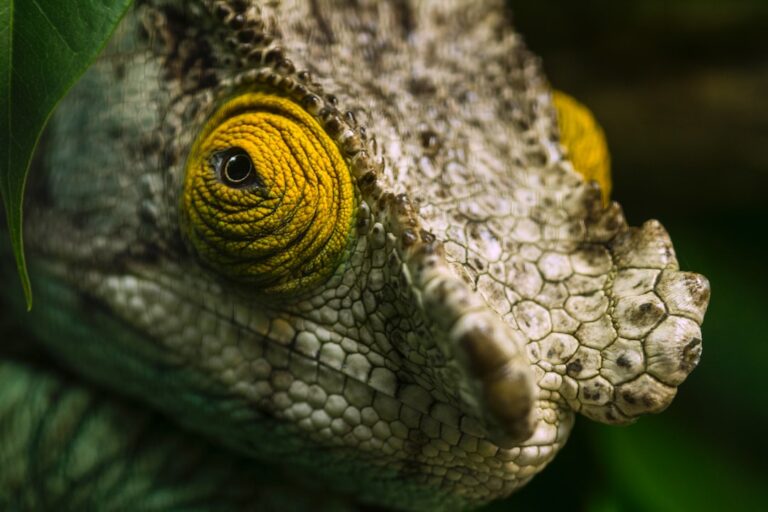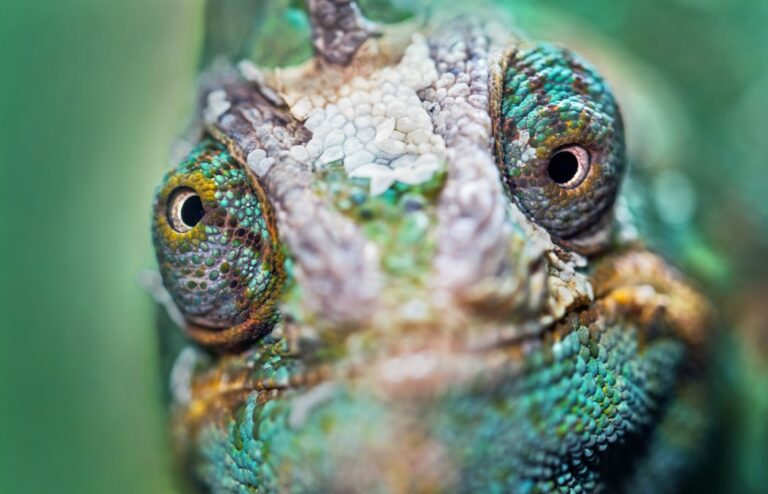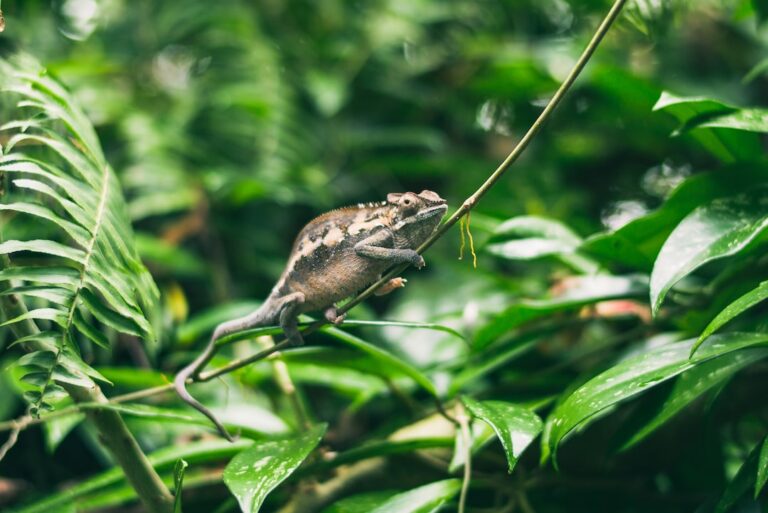Can Chameleons Hang from Their Tail?
Chameleons are fascinating creatures that are known for their ability to change color and blend into their surroundings. They belong to the family Chamaeleonidae and are native to Africa, Madagascar, and parts of southern Europe and Asia. Chameleons have a unique set of characteristics that make them stand out among other reptiles.
One of the most notable traits of chameleons is their ability to change color. They can change their skin color in response to their mood, temperature, or to communicate with other chameleons. This ability is due to specialized cells called chromatophores in their skin that contain pigments. When these cells expand or contract, they can change the color of the chameleon’s skin.
Another unique trait of chameleons is their independently moving eyes. Each eye can move and focus on different objects simultaneously, allowing them to have a 360-degree field of vision. This gives them excellent depth perception and the ability to spot prey or predators from different angles.
Table of Contents
Anatomy of a Chameleon’s Tail
The tail of a chameleon is an important part of its anatomy and serves several functions. It is made up of several vertebrae that are connected by flexible joints, allowing the tail to move in various directions. The tail also contains muscles that enable the chameleon to control its movements.
At the end of the tail, there is a prehensile appendage called the prehensile tail. This specialized structure allows the chameleon to grasp onto branches and hold onto them securely. The prehensile tail is covered in small scales that provide traction and grip.
Chameleons’ Ability to Climb and Grasp onto Branches
Chameleons are excellent climbers and use their tails as an additional limb to help them navigate through their environment. They have a unique ability to curl their tail around branches and hold onto them securely. This allows them to move easily through the trees and reach their desired locations.
The prehensile tail of a chameleon is highly flexible and can be wrapped around branches of various sizes. The chameleon uses its tail to anchor itself while it moves its other limbs to reach for the next branch. This tail-assisted climbing technique allows chameleons to move with agility and precision.
The Role of a Chameleon’s Tail in Balance and Stability
The tail of a chameleon plays a crucial role in maintaining balance and stability. As chameleons move through their environment, they often encounter uneven surfaces or unstable branches. In these situations, the tail acts as a counterbalance, helping the chameleon maintain its equilibrium.
The tail also contributes to the overall stability of the chameleon’s body. It helps distribute the weight evenly and prevents the chameleon from toppling over. This is especially important when the chameleon is perched on a thin branch or when it is reaching for prey.
Can Chameleons Hang from Their Tail? Debunking the Myth
Contrary to popular belief, chameleons cannot hang from their tails. While their tails are strong and flexible, they are not designed to support the weight of the entire body. Hanging from the tail would put excessive strain on the vertebrae and could potentially injure the chameleon.
The misconception that chameleons can hang from their tails may have originated from observing their ability to grasp onto branches with their tails. However, this is a different mechanism that allows them to hold onto branches while using their other limbs for support.
Observations of Chameleons in the Wild
Observing chameleons in their natural habitat provides valuable insights into their behavior and how they use their tails. In the wild, chameleons are often found in trees and shrubs, where they blend into their surroundings and wait for prey to pass by.
Chameleons use their tails to anchor themselves to branches while they scan their surroundings for potential prey. They can move their tails in a slow, deliberate manner to maintain balance and stability. When they spot prey, they use their long, sticky tongues to catch it and bring it back to their mouths.
The Importance of Understanding Chameleon Behavior
Understanding chameleon behavior is crucial for their care, whether in captivity or in the wild. By understanding how chameleons use their tails and other adaptations, we can provide them with suitable environments and ensure their well-being.
For example, in captivity, it is important to provide chameleons with branches and perches that allow them to climb and move freely. The branches should be of different sizes and textures to mimic their natural habitat. Additionally, providing a stable and secure enclosure will help prevent injuries and stress.
Caring for Chameleons in Captivity
Caring for chameleons in captivity requires attention to detail and a thorough understanding of their needs. Chameleons are arboreal creatures, meaning they spend most of their time in trees. Therefore, it is important to provide them with a tall enclosure that allows for vertical movement.
The enclosure should be well-ventilated and have proper lighting and heating to mimic the chameleon’s natural habitat. UVB lighting is essential for chameleons as it helps them synthesize vitamin D3, which is necessary for calcium absorption.
In addition to providing a suitable environment, it is important to feed chameleons a varied diet consisting of live insects such as crickets, mealworms, and waxworms. Gut-loading the insects with nutritious food before feeding them to the chameleon ensures that they receive the necessary nutrients.
Common Misconceptions About Chameleon Tails
Aside from the misconception that chameleons can hang from their tails, there are other common misconceptions about chameleon tails. One such misconception is that chameleons can regenerate their tails like some other reptiles. However, chameleons do not have the ability to regenerate lost tails.
Another misconception is that the color change of a chameleon’s skin is solely controlled by its mood. While mood can influence color change, there are other factors such as temperature, light, and social interactions that also play a role.
Appreciating the Fascinating Adaptations of Chameleons
Chameleons are truly fascinating creatures with unique traits and adaptations. Their ability to change color, independently moving eyes, and prehensile tail make them stand out among other reptiles. Understanding their behavior and providing them with suitable environments is crucial for their well-being in captivity.
Observing chameleons in the wild provides valuable insights into their natural behavior and how they use their tails to navigate through their environment. By appreciating and understanding the fascinating adaptations of chameleons, we can better care for them and ensure their survival in the wild.
If you’re interested in learning more about reptiles, you might also enjoy reading the article “Can Chameleons Eat Lettuce?” on Reptile Friend. This informative piece explores whether chameleons can safely consume lettuce as part of their diet. Click here to check it out!







